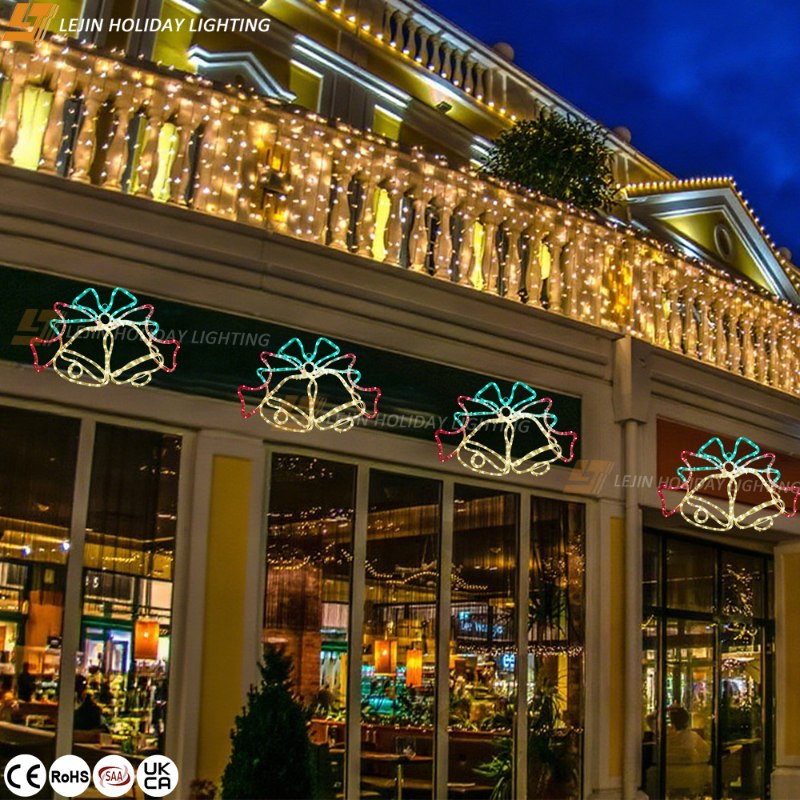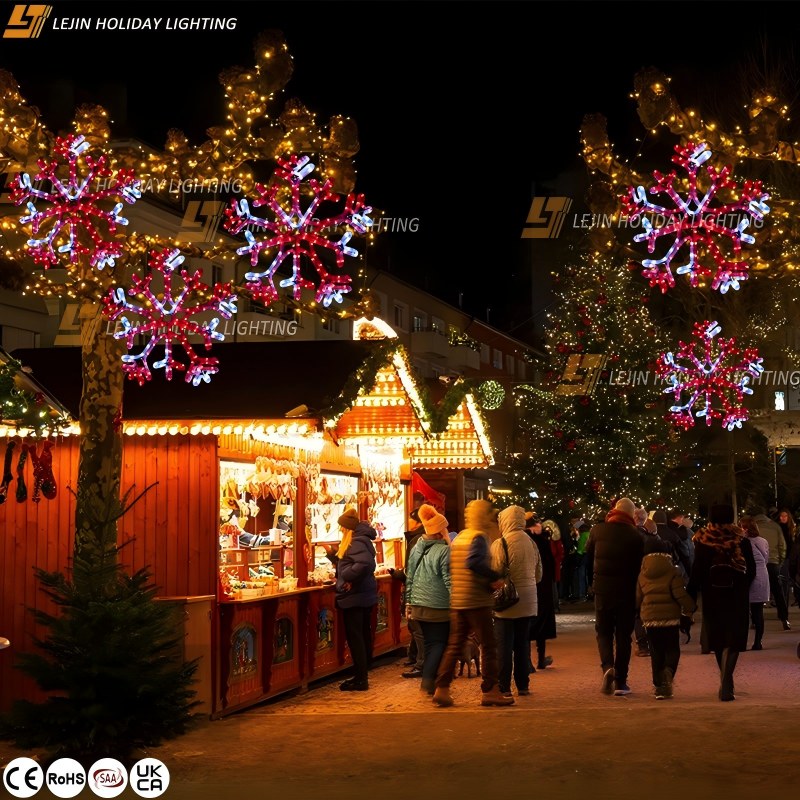2D/3D Motif Lights: Tips for Using in Street Public Areas
Aug 07, 2025
In festive decorations for street public areas, motif lights are the core elements for creating an atmosphere. Whether it’s the bustling night view of commercial streets or the warm ambiance of community roads, 2D and 3D motif lights can transform ordinary street spaces into vibrant scenes with their unique shapes and light effects. Each has its advantages, and skillful use not only enhances decorative aesthetics but also balances practicality and durability, allowing streets to showcase unique festive charm in different scenarios.
Choosing by Area: Selecting Motifs That Fit Spatial Characteristics
Street spaces vary in form, from narrow sidewalks to open plazas, and each scenario demands different shapes and sizes of motif lights. Choosing the right ones ensures decorations are neither obtrusive nor ineffective.
Sidewalks, as high-traffic areas for pedestrians, are usually narrow, with green belts or shops on both sides. Thus, motif lights here must prioritize "not obstructing passage." 2D LED motif lights feature a flat design with thin thickness—whether it’s flat snowflakes, stars, or festive symbols, they can easily attach to lamp posts, railings, or shop exteriors. For example, along community sidewalks, 2D Santa-themed LED motifs can be fixed on lamp posts at a height above pedestrians’ line of sight, avoiding interference with walking while conveying a festive vibe. Additionally, 2D motifs can be arranged continuously along sidewalks, forming a coherent decorative belt that makes pedestrians feel as if they’re wandering through a festive scene.
Open areas like plazas and main roads are better suited for 3D outdoor motif decorations. These spaces are spacious with high foot and vehicle traffic, requiring motif lights with strong visual impact. 3D motif lights, with their three-dimensional outlines and full shapes, become focal points without dense arrangement. For instance, in small plazas at street intersections, a 3D Christmas tree motif with glowing gift boxes can attract pedestrians to stop; in green belts along urban main roads, several sets of 3D reindeer and sleigh motifs let passengers in passing vehicles quickly catch festive messages. In central areas of large plazas, a several-meter-tall 3D castle-shaped LED motif can fill the emptiness while creating rich layers through layered lighting.
Commercial streets need to balance "attracting customers" and "not affecting business operations," making the combination of 2D and 3D motifs crucial. 2D festive motifs, such as flat lanterns and ribbons, are ideal for hanging above shop doors—they echo the theme without blocking signs. 3D decorative motifs, like 3D cartoon characters, placed at commercial street entrances or central nodes serve as landmarks, effectively drawing customers from afar.
Environmental Adaptation: Durable Designs for Complex Outdoor Scenes
Street environments are exposed to natural conditions year-round, with wind, sun, rain, and snow. The durability of motif lights directly determines the longevity of decorative effects and maintenance costs. Both 2D and 3D motifs require special treatments for outdoor scenarios.
Frames of 2D weather-resistant motif lights often use durable materials like anti-corrosion metal or high-strength plastic, with anti-UV coatings on the surface to resist fading and rust. In rainy areas, edges and joints of 2D motifs are sealed to prevent water infiltration; in foggy or high-humidity regions, moisture-proof components are added to avoid bulb short circuits. For 2D metal-framed motifs in coastal street areas, galvanized treatment on the metal resists salt spray corrosion.
Beyond basic weather resistance, 3D outdoor motif lights emphasize overall stability. Their bases often have weighted designs or reserved fixing ports—3D motifs in windy northern streets can be fixed with expansion screws to prevent shaking; bases in sloped streets are height-adjustable to ensure level placement. For hollow or protruding parts of 3D structures, bulbs are installed embedded to prevent falling due to vibrations, making them especially suitable for main roads with heavy traffic.
Internal wires of both types undergo special treatment, using high and low-temperature resistant materials to adapt to temperature differences from sub-zero winters to hot summers, reducing wire aging or breakage and ensuring long-term stable lighting.
Installation and Maintenance: Practical Considerations for Simplified Processes
Street decoration construction must not disrupt traffic or pedestrians, so the installation and maintenance processes of motif lights directly affect efficiency and experience. Both 2D and 3D motifs enhance convenience through optimized structures.
2D easy-install LED motifs are lightweight with flexible installation methods—snap fixing, hook hanging, etc., require no complex tools and can be operated by one person. Installing 2D motifs on lamp posts takes less than 5 minutes: fix with snaps and connect to power. For shop glass windows, non-marking hooks can hang 2D motifs for easy position adjustment. For large-area decorations, 2D motifs can be pre-assembled into strings on the ground and then hung as a whole; two people can quickly complete dozens of meters of decoration.
3D motif lights, though slightly larger, adopt modular designs—main bodies and components can be transported separately, and on-site assembly with snaps or screws requires no professional skills. For example, 3D Christmas tree motifs, with trunks, branches, and top stars packed separately, can be assembled within half an hour on-site.
In terms of maintenance, surface dust can be wiped off with a soft cloth without special cleaners; wire joints are waterproof and sealed, requiring only visual checks for looseness during daily inspections; bulbs have plug-in designs, allowing single replacement when damaged. Power adapters are installed in hidden, rainproof locations for easy inspection. After festivals, 2D motifs can be folded for storage, and 3D motifs can be disassembled and packed, stored in dry and ventilated places, and reused with simple checks the next year.
Brightness and Energy Efficiency: Balancing Visual Effects and Costs
Street lights need to ensure clear visibility of motifs at night while being energy-efficient to avoid high electricity bills. 2D and 3D motif lights achieve this balance through light source design and brightness control.
Light sources of 2D energy-saving LED motifs are densely arranged along contours, ensuring clear outline of details at night. The light, mostly warm white or festive-themed colors, is soft and non-dazzling, suitable for continuous lighting on sidewalks or outside shops. 2D motifs on community streets are set to a brightness that "shows the shape without disturbing residents’ rest," lit from evening to late night with low power consumption for energy savings.
3D LED motifs have more layered brightness designs: main bodies use high-brightness light sources to highlight outlines, while details use low-brightness ones to enrich layers and enhance depth. They also support brightness adjustment—plaza areas use high brightness from evening to 10 PM, switching to energy-saving mode late at night to balance atmosphere and efficiency.
Some smart outdoor motifs can connect to street intelligent lighting systems, with light sensors automatically adjusting lighting time, timers setting weekly schedules, and remote control for full brightness during festivals and energy-saving mode afterward, requiring no manual operation.
Style Coordination: Scene-Based Matching of 2D and 3D Motifs
The overall sense of street decorations affects the immersion of the atmosphere. 2D and 3D motifs need to be matched around a unified theme, forming a coherent visual experience through echoed shapes, colors, and sizes.
In Christmas-themed streets, 3D outdoor Christmas tree motifs (2-3 meters high) are placed in green belts along main roads, with green light sources on crowns, golden star lights on top, and white snowflake light strings around the base; white and gold 2D snowflake and bell motifs are hung on sidewalk lamp posts to echo the color scheme. At street intersections, 3D sleigh and reindeer motifs are placed, surrounded by 2D gift box motifs, forming a "3D core + 2D embellishment" combination. 2D Christmas stocking motifs are hung above shop doors to unify styles between commercial and public spaces.
Cost Control: Economic Planning for Long-Term Use
Street decorations need to consider long-term costs. Choosing motif lights requires balancing initial purchase and later maintenance expenses to maximize economy.
2D budget-friendly LED motifs have low initial purchase costs, and their simple structure keeps maintenance costs manageable. Using 2D motifs for large-area decorations reduces initial investment; high-quality products can be used continuously for 3-5 years, with only individual bulbs needing replacement—far cheaper than frequent replacement of low-quality products. For budget-constrained community or small commercial streets, covering main areas with 2D motifs and adding a few 3D ones at key nodes balances effect and expenditure.
3D high-impact motif lights have higher initial investment but reduce the number of decorations due to their striking visual effects, lowering "per square meter costs." A high-quality 3D motif in a large plaza can cover dozens of square meters, making it more economical in the long run. Their modular design enables flexible maintenance—damaged components can be replaced individually, suitable for main roads or plazas with long-term use.
When purchasing, choose high-quality, durable models for fixed festivals to lower long-term costs; for temporary events, select mid-range models to balance effect and cost. Bulk purchasing of 2D and 3D motifs from the same series unifies styles, reduces unit prices, and saves maintenance costs through universal accessories. Choosing the right type based on scenarios and balancing investment and maintenance ensures street decorations are both beautiful and economical.
Read More

